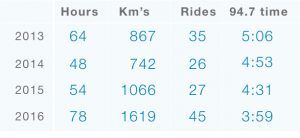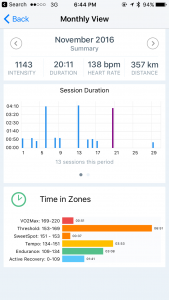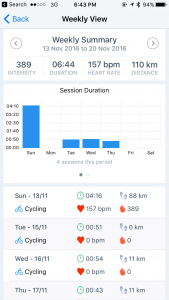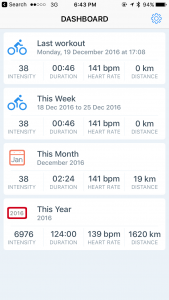In 2013 I was bitten by the cycling bug. It started when I was persuaded to join some friends mountain biking. They had bought expensive mountain bikes and wanted to test them out a local mountain biking trail. So I joined them with my department store special. That first ride was hard. But I was hooked. I soon swapped out my department store bike for a second-hand MTB bike.
I was riding nearly every week after that. Pretty soon I decided to enter the 94.7 km cycle challenge. The second largest cycle timed cycle event in the world. I had aspirations of finishing the race in under 4 hours. Alas, it took me 5 and half hours. From then on, my goal has been to complete the race in under 4 hours.
It took me almost four years, but I finally achieved it. In November 2016, I completed the 94.7 Cycle Challenge in 3hrs 59 minute. So what was different in 2016? The table below provides you with a hint.

Consistency. In 2016 I trained more and rode more than I ever had before. This was despite the fact that I only started training in July.
As I look forwards to 2017, the question I’ve asked myself is “Why was I so consistent this time?”. I’ve narrowed it down to three factors.
- I made a conscious effort to “not break the chain” (i.e. The Seinfeld Strategy).
- I had an accountability partner who had a vested interest in me training consistently.
- I gamified training by getting super analytic about the training results.
The Seinfeld strategy, as I explained in my last post, is a method of forming consistency by creating a chain on a calendar. Now, I wasn’t going to train daily. My aim was around 3 to 5 sessions a week. If I reached three, then the entire week would get a tick.
Of course, saying you want to be consistent is very different from actually being consistent. That’s where my accountability partner came in. Someone who could train with me and in so doing, keep me accountable for not missing a session.
The final step was to gamify the process by analysing all my training statistics for the previous years and setting goals to beat them. This was not so easy. For one, my training statistics were spread over multiple web platforms. Strava, Garmin, Polar, Apple Health and the web platform my local gym used.I needed a way to combine my training data from the different fitness platforms I was using. So I built an app.




The app allowed me to track my workout frequency and intensity weekly, monthly and yearly. My aim was to always do better than yesterday, last week or last month and this motivated me to never miss a training session.
This experience led me to the following personal statement:
I can achieve more than I believed possible if I have some consistency. But to achieve consistency I need an emotional attachment to the task. This can be writing about it, using an accountability partner or combining it with a technology interest.
I plan to test this theory of mine in 2017 but more on that( and the story of how I built the app) in an upcoming blog post.